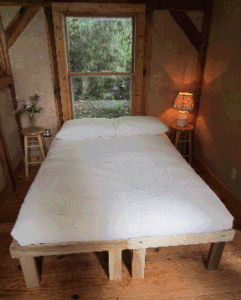When I was in highschool I was inspired by Henry David Thoreau who lived in a 10’x10′ cabin as an experiment in self awareness and personal independence from herd mentality. Ever since, I had the ideal that living in a small space would be beautiful and simple.
A small space offers a form of resistance or a boundary for me that feels safe and comforting. A small space helps me focus and inspires creativity. A small space has all the things I want: hassle-free, flexible, organized, easy to maintain, easy to move.
However, it has taken many years to organize myself to fit easily into a 9’x12′ bedroom and I want to share part of my journey here. If I could find a way to thrive and peacefully exist in a small space, I would be more satisfied because I would focus more on the few things I enjoy the most and not keep getting distracted. I found that the space would actually shape me and make me get my act together.
Perhaps my design process started when I was a child exploring nature. I would find a cool places to hang out. I would climb a tree and sit on a limb for hours. I would build primitive shelters from sticks, leaves, bark and grass and go inside to dream or lay outside watching the clouds. Certain austere settings brought out a whole new dimension in my state of mind. I spent many summers sleeping in the yard in a tent. I took my book, drawing materials, or toys with me, because it was so much more fun than playing inside.
Most indoor spaces seemed clunky, boring, dead, and too serious so I was constantly wandering. Nothing INSIDE a building could compare to the wild outdoors. Later I got into design and I worked on making indoor environments into the inspiring, stimulating places I found in nature.

North View of my Tiny Bedroom/Home Office
Modular EcoSquares™ and 2
Organic 1/2 Queen Futons make this Queen Bed. Underbed storage is essential since there are no closets. Multi-purpose stools used here as bedstands.
What I found went way beyond interior design. The process took me on a journey of inner exploration and discovery, which has been an adventure and a challenge.
This was no small matter. To go small meant re-inventing my lifestyle into something other than what people around me were doing and what was presented on the media. This design process was way bigger than merely drawing lines on paper and putting building materials together in certain ways. Designing a living space went hand in hand with designing a life for myself that felt right. I had not heard of the word ‘minimalism’ because I was too young to understand that. It was a relief to later find I wasn’t the only one thinking like this. Now I felt legitimate–I belonged somewhere.
The trick was to downscale my life to a point that felt spacious and not cramped. But just HOW small a space would fit? How small could I go without feeling limited and stifled?
I started seeing a dynamic–almost everything, I mean EVERYTHING, is a give and take. You have to give up wall space if you want more windows. You have to give up belongings if you want to be more simple and clutter free. You have to give up stability if you want to travel and explore.
We each tend to want it all. We like the windows, but we demand the wall space. We want to be simple, organized, and clutter-free, but we want our stuff and have a hard time letting go.
I have been constantly re-arranging the furniture for years trying out different ideas. Usually when I present a new idea to someone, the first reaction starts with the word ‘but…’ Something like, ‘But you have just broken a design rule.’ For example, “But the room is too small. You should just add on rather than try to make something work that is doomed for failure.’ “I like the window but I could never live in that small a space.”
Or “I do yoga on the floor, but I don’t want to sleep or sit on the floor’, or “But I need more stuff in my life to feel comfortable and settled.” Or ‘When I am working out, I don’t mind exercise. But I don’t want to stand up WHILE I am in the office. When I am at home relaxing I would love a lounge chair, but I don’t want to sit like that and relax WHILE I work. I would appear weak, lazy, or I would fall asleep.
These reactions were very important feedback that I had to work with until I found a place where there were no more ‘buts’. If an idea gets rejected I go back to the drawing board and work on it some more.
For instance, some people didn’t like or could not get down to the floor. So I designed a platform (EcoSquare™) that all the floor seats could be placed on to put them at standard heights.
Improving a design by bringing it to it’s smallest common denominator is more difficult than improving a design by adding something else to it. My design process is like alchemy. The solution lies in getting the right arrangement which then creates a synergistic dynamic that is more than the sum of the parts. The solution lies in the harmonious interactions of the components in the space and how it effects the body/mind/spirit.
Minimalism had been an integral part of the Japanese lifestyle and culture for centuries. I call it the ‘Island Philosophy’. I realized I was working in a culture (America) that had a different set of values and aesthetics. Mine were so aligned with the Japanese and other traditional cultures that I sometimes wondered why I was even bothering to try to convince Americans that my ways were valid. They would be immediately recognized in Japan, but I wasn’t there. I was seriously considering finding another profession when a new trend appeared.
The aesthetic of simplicity and minimalism and creating sanctuary in the home found a new foothold in America over the past few years. The ‘Island’ philosophy of Japan that caused them to value minimalism and small because they recognized tangible limits was finally maybe for the first time settling into America. Also the ‘Nomadic’ philosophy where minimalism is the easiest way to live due to frequent uprooting was coming into play.
“The 100 Thing Challenge is about getting out of jail — the prison of American-style consumerism. It’s about breaking free from the shackles of always feeling like we need to get more stuff in order to get to the dream life. (Ever notice how we just keep getting and getting stuff, but we never arrive at the dream life? What a mess!)” www.guynameddave.com
I started seeing the Japanese koan concept in everything. The design process brings up the issue of paradox and paradox is where the rubber meets the road between ideals and reality. There is some kind of powerful sublime gift in the process of carefully considering two opposing factors for a period of time–like the issue of finding enough wall space with enough window space. By contemplating and holding the question in mind with enough intensity until clarity and insight finally arrive, there is a place where logic let’s go of its grip and a solution appears automatically.
So here is this beautiful bedroom which has incredible light, view and charm and feels like you’re outside. But it appears there is actually not enough room to live in. How can you fit a queen bed AND clothes and personal belongings, INCLUDING office, inside a 9’x12′ space? There are no closets, but there is an exceptionally tall ceiling of 11 feet. I wanted some floor space to do yoga.
I have rearranged my 9’x12’ bedroom many times over the past several years and developed an entire line of furniture until I finally came up with an arrangement that not only works—but ROCKS. 9’x12’ is not a lot of space to work with. That is the ENTIRE space. Plus there are so many windows wall space is virtually non-existant. So how do you store all your belongings, sleep, play and work in that small of a space?
The way you do it is design new furniture that doesn’t currently exist. The limits or the design criteria are forcing some new ideas to emerge to solve the problem. A design ‘crisis’ is a design ‘opportunity’. Go UP if you can’t go OUT (use verticle space). Use underbed storage. Big windows with natural light makes the room feel more spacious than a huge room with less windows. Get rid of some stuff. Set aside time to stay organized. Use lightweight items that can be rearranged for multi-purpose. Question your assumtions about why you really need more space. Adapt to the situation. See what peace and beauty might come out of accepting things, not just your room, as they are.
One really huge discovery is the idea of using verticle space for desk and counter use. The stacking EcoShelfs™ are partly used for storage but also for desk use and as a place to set things down. This takes some getting use to but is actually perfectly as workable as a standard desk which uses 300% more floor space. The concept of A home for ‘Everything And Everything in its home’ becomes essential. Just one or two things set on the floor or bed and suddenly there’s a mess.
Another discovery is the concept of changing into different positions and work stations throughout the day instead of just sitting at a desk. This I call the ‘Body Friendly Office™’. It is an idea borrowed from the hunter-gatherers and research that showed the human body is designed for walking and movment.
Another concept, borrowed from the Japanese, is using one room for more than one purpose. The bedroom becomes a living room, office, or whatever simply by rearranging the furniture. We so take for granted that each room needs a unique purpose. Yes, to have the luxury to have a nice room set aside for each activity is nice, but it’s not the only way to enjoy a highly functional, clutter free, and inspiring space. If you are lucky enough to have enough money to do it all, you may not be interested in this whole idea of living in a small space. However, if you are trading a bigger house and mortgage or rent payment for traveling or doing other fun things you like to do, this just might fit into your paradigm.
I built a house the opposite of the accepted Architectural pattern where the house is built around the furniture. I was actually building furniture around a house. The reason was to inspire new possibilities not before thought of in furniture and space arrangement. Ancient Japanese had some great ideas, but didn’t accomodate many modern needs like using a computer for instance. So how can one adapt ancient design principles which considered the body/mind/spirit into the modern setting? The need was huge because the modern setting does not consider the body. It puts the body into a zombie-like state of contortion which fuels the medical establishment including chiropractors and makes us into bent over ‘couch potatoes’.
